For the best results, you'll want to start your red light therapy session within 10-20 minutes after completing your workout. This timing maximizes the therapy's effectiveness in reducing muscle soreness and accelerating tissue repair when your muscles are most receptive to recovery support. You should aim for sessions lasting 10-20 minutes, ensuring direct skin exposure for the best absorption. While pre-workout sessions can boost performance, post-workout treatments specifically target inflammation reduction and faster recovery. Consistent sessions 3-5 times per week, combined with proper hydration and other recovery methods, will help you tap into the full potential of red light therapy benefits.
Immediate Post-Workout Recovery Benefits
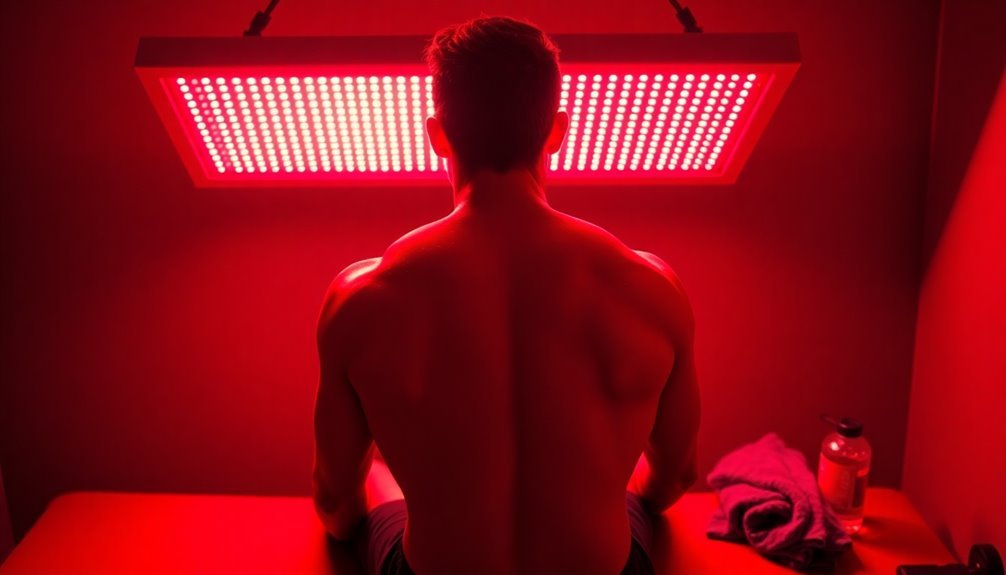
Timing is everything when it comes to post-workout recovery. Your body enters a vital recovery phase immediately after exercise, and what you do in the first hour can markedly impact your fitness results.
Within just 10 minutes of completing your workout, you'll want to start your recovery routine to prevent blood from pooling in your limbs and promote better circulation throughout your body.
You'll maximize your recovery benefits by gradually shifting from high-intensity exercise to a resting state. This means incorporating light movement while your heart rate decreases, which helps kickstart your body's repair process. During this window, you're setting the stage for improved muscle growth, reduced injury risk, and enhanced performance in future workouts. A protein-carb snack within 30 minutes post-exercise will help jumpstart your recovery process.
Your immediate post-workout actions directly influence how you'll feel in the days following exercise. By maintaining movement at 30-60% of your maximum heart rate for 20-30 minutes, you'll support proper blood flow and muscle repair.
This approach helps minimize muscle soreness and maintains your energy levels for upcoming training sessions, creating a foundation for consistent progress in your fitness journey.
Optimal Treatment Windows
You'll get the most benefits from red light therapy when you use it immediately after your workout, during the critical recovery window.
For peak performance results, plan your post-exercise sessions to last 10-20 minutes, focusing on the muscles you've just worked. Exposing bare skin directly to the light ensures maximum effectiveness since clothing can block proper light penetration.
If you're committed to a long-term fitness routine, schedule your red light therapy sessions 3-5 times per week, maintaining at least 6 hours between treatments for the best cellular response.
Immediate Recovery Window
The post-exercise window presents a vital opportunity for maximizing red light therapy's benefits. You'll want to start your treatment within 10-20 minutes after your workout, as this is when your muscles are most receptive to light absorption.
For ideal results, aim to maintain consistency with 3-4 sessions per week. Sessions should be at least 6 hours apart if you plan multiple treatments in one day.
To get the most from your treatment, you'll need to expose bare skin directly to the light and stay well-hydrated throughout the process. The combination of red and near-infrared light can provide enhanced recovery benefits, particularly when you're targeting muscle soreness and regeneration.
You'll need to pay attention to irradiance levels, which should fall between 20-200 mW/cm². For muscle recovery specifically, target higher levels (100-200 mW/cm²), while pain management responds better to moderate levels (50-100 mW/cm²).
It's essential to adjust these levels based on your skin type and treatment area to avoid overheating or irritation.
Remember to think about your specific goals when planning your treatment. Whether you're focusing on muscle recovery, pain relief, or anti-aging, the immediate post-workout period remains your ideal window for maximum effectiveness.
Peak Performance Timing
Strategic timing of red light therapy sessions optimizes peak athletic performance when you plan treatments several hours before exercise. For maximum benefits, you'll want to schedule your session 3-6 hours before your workout, allowing time for ATP production and muscle activation to peak.
A 10-15 minute pre-exercise treatment can effectively prepare your muscles and reduce injury risk. When you're consistent with treatment 3-5 times per week, you'll notice improved endurance, reduced fatigue, and enhanced muscle performance. The therapy increases blood flow, warming your muscles and enabling you to lift heavier or run faster.
You'll get the most from red light therapy by integrating it into your regular fitness routine. Morning sessions can be particularly effective, as they mimic natural sunrise and boost cellular energy production. Proper sleep quality is enhanced when sessions are scheduled before bedtime.
While both pre and post-workout sessions have their benefits, pre-conditioning your muscles helps minimize damage during physical activity and reduces recovery time.
Remember that red light therapy isn't a replacement for proper training – it's a complementary tool that works best when combined with good nutrition and adequate rest. Plan your sessions strategically to maximize your athletic performance and recovery potential.
Long-Term Session Planning
Developing a consistent red light therapy schedule requires careful planning of treatment windows to maximize long-term benefits. You'll want to establish a routine that aligns with your workout schedule and specific recovery needs, aiming for 3-4 sessions per week as a baseline.
For general wellness and recovery, consider these key scheduling elements:
- Start with shorter 5-10 minute sessions during your first few weeks, then gradually increase to 10-20 minutes as your body adapts.
- Schedule post-workout sessions within 20 minutes of exercise completion for maximum muscle recovery benefits.
- Plan 6-15 minute sessions, 3-5 times weekly for pain management protocols.
- Incorporate both pre-workout (3-5 minutes) and post-workout (10-20 minutes) sessions for enhanced performance.
- Allow flexibility in your schedule for longer sessions (15-30 minutes) when addressing chronic conditions.
When planning your long-term therapy schedule, consider your device's irradiance levels. Higher intensities (100-200 mW/cm²) work best for muscle recovery, while moderate levels (50-100 mW/cm²) suit pain management needs. Professional treatment plans may require longer and more structured sessions in clinical settings.
Maintain consistency in your chosen time slots to establish a sustainable routine.
Timing For Maximum Results
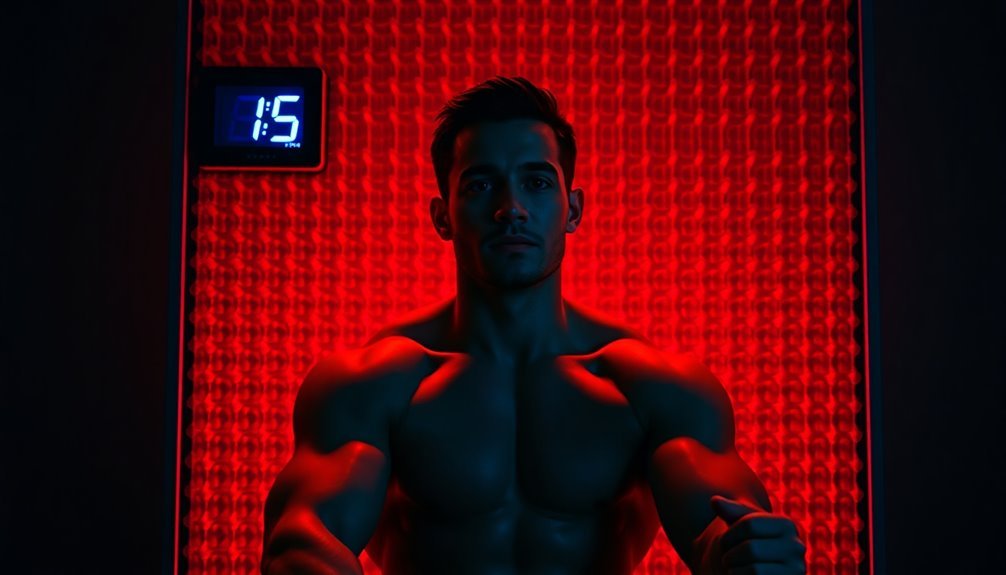
Proper timing of red light therapy after exercise can substantially amplify its recovery benefits. For ideal results, you'll want to start your therapy session immediately after your workout, when your muscles are still warm and responsive to treatment. Position yourself 10-15 cm from the light source and expose bare skin directly to the light for 10-20 minutes. Regular sessions can help maintain cumulative benefits over time for optimal results.
| Timing | Benefits |
|---|---|
| Immediate Post-Exercise | Kickstarts recovery, reduces acute inflammation |
| Evening Sessions | Enhances melatonin production, improves sleep quality |
| Pre-Bedtime | Promotes relaxation, aids muscle repair during sleep |
To maximize your results, maintain a consistent schedule of 3-4 sessions per week with at least one day between sessions. You'll want to stay hydrated during this time, as water helps facilitate the cellular processes that red light therapy enhances. While you can make up for missed sessions with back-to-back treatments, avoid doing multiple sessions in a single day. Remember that your device's power output will influence the ideal session duration, so adjust your exposure time accordingly. For athletes focusing on recovery, combining immediate post-workout sessions with evening treatments can provide thorough benefits.
Pre-Exercise Light Therapy Options
You'll get the most from red light therapy by using it 10-15 minutes before your workout, allowing time for enhanced blood flow and muscle preparation.
Your energy levels will naturally increase as the therapy boosts ATP production and improves cellular oxygenation in your target muscle groups.
Mental clarity and focus improves significantly when using red light therapy before exercise, helping you maintain proper form during workouts.
For ideal muscle preparation, focus the therapy on specific muscle groups you'll be training, maintaining a 6-12 inch distance from the device while applying it for 5-10 minutes per area.
Timing For Maximum Benefits
The strategic timing of pre-exercise red light therapy plays a crucial role in maximizing workout performance and preventing injury. You'll want to schedule your session 3-5 minutes before your workout to achieve superior results, though some athletes benefit from longer 10-15 minute sessions for enhanced mental focus and physical readiness. By implementing pre-workout red light therapy, your body can experience increased mitochondrial production, leading to enhanced cellular energy during exercise.
For the most effective pre-workout treatment, consider these key timing factors:
- Direct exposure must be consistent and properly timed to activate muscle preconditioning
- Sessions shouldn't exceed the point where devices become hot to touch
- Wavelengths between 640-950 nm require precise timing for maximum effectiveness
- Your specific workout type (strength vs. endurance) may influence superior timing
- LED power output of 10-35 mW needs appropriate duration for safety
You'll get the best results by maintaining a regular pre-exercise light therapy schedule that aligns with your workout routine. While 3-5 minutes is the standard recommendation, you might need to adjust this timing based on your personal fitness goals and exercise intensity.
Energy Level Enhancement
Beyond timing considerations, pre-exercise light therapy offers impressive energy-boosting benefits that can transform your workout performance. When you expose your muscles to red and near-infrared light before exercise, you'll experience enhanced ATP production at the cellular level, leading to improved energy availability during your workout.
You'll notice significant improvements in muscle performance as the increased ATP levels combine with reduced oxidative stress to maximize your body's function. The therapy triggers vasodilation, which enhances blood flow and oxygen delivery to your muscles, directly contributing to better endurance and stamina during training sessions.
For peak energy enhancement, you'll want to aim for 5-10 minutes of exposure per muscle group, using wavelengths between 630-700 nm for red light or 700-1200 nm for near-infrared light. Position yourself 6-12 inches from the device, and don't exceed 60 Joules per session, as higher doses might counteract the benefits.
While you can use light therapy daily, you'll get the best results by applying it 3-6 hours before your workout rather than immediately pre-exercise, allowing your body to fully utilize the enhanced cellular energy production.
Muscle Preparation Protocol
Implementing an effective pre-workout light therapy protocol requires careful attention to specific muscle groups and timing strategies. You'll want to begin your session 10-15 minutes before exercise, focusing on the areas you'll target during your workout.
For best results, combine the therapy with your regular warm-up routine to enhance muscle preparation and prevent potential injuries.
To maximize the benefits of your pre-exercise red light therapy, follow these essential protocol steps:
- Position the device 3-5 minutes before your workout starts, ensuring direct contact with target muscle groups
- Maintain consistent exposure for 10-15 minutes while performing light stretches
- Keep sessions at least 6 hours apart if you're training multiple times per day
- Adjust the intensity based on your specific fitness goals and muscle groups
- Combine therapy with dynamic stretching for enhanced blood flow and muscle activation
Remember that your pre-workout protocol should align with your training objectives, whether that's muscle growth, endurance, or performance enhancement. The therapy works by promoting ATP synthesis and improving blood flow, which helps prepare your muscles for the upcoming workout.
You can customize the duration and intensity based on your individual needs while maintaining the recommended minimum exposure times.
Session Duration Guidelines
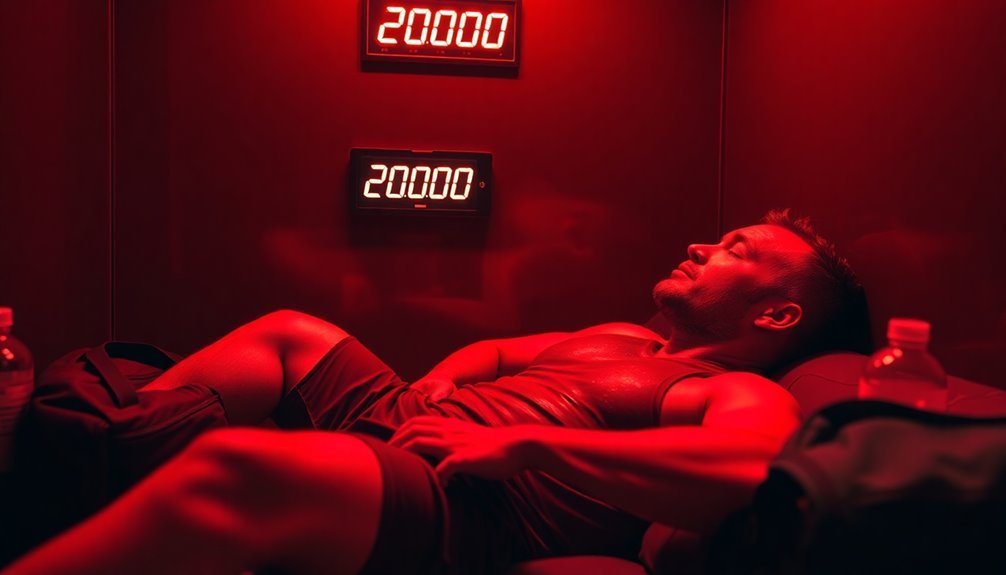
Determining the right duration for your red light therapy sessions requires careful consideration of several key factors. For post-workout recovery, you'll want to aim for 10-20 minutes of treatment, though your specific needs may vary based on your age, fitness level, and the intensity of your exercise.
If you're new to red light therapy, start with shorter 5-10 minute sessions and gradually increase the duration as your body adapts.
You'll find that 10-15 minutes is typically sufficient for general wellness and basic muscle recovery. However, if you're dealing with chronic pain or inflammation, you might need to extend your sessions to 15-30 minutes.
Your age also plays a vital role in determining session length. If you're a young adult, 15-25 minutes should effectively support your muscle recovery. For older adults, you may need the full 30-minute sessions due to slower recovery times.
Remember that consistency is key – regular sessions will yield better results than sporadic treatments.
You can also complement your post-workout therapy with brief 3-5 minute pre-workout sessions to help prevent injury and optimize your exercise performance.
Multiple Session Scheduling Strategies
When planning multiple red light therapy sessions around your workouts, you'll get different benefits from morning versus evening treatments, with morning sessions supporting pre-exercise performance and evening sessions focusing on recovery.
You can optimize your results by splitting sessions between pre and post-workout periods, allowing at least 6 hours between treatments.
To create an effective schedule, consider your workout timing first, then plan your morning session 3-6 hours before exercise and your evening session immediately after or within a few hours post-workout.
Morning Vs Evening Sessions
The timing flexibility of red light therapy presents unique opportunities for both morning and evening sessions, each offering distinct advantages for exercise enhancement.
Morning sessions can boost your energy and ATP production, making them ideal for pre-workout routines, while evening sessions excel at promoting recovery and enhancing sleep quality through improved melatonin production.
When deciding between morning and evening sessions, consider these key factors:
- Morning sessions boost alertness and prepare muscles for workouts, reducing injury risk
- Evening sessions enhance post-workout recovery and help regulate sleep cycles
- Pre-workout sessions can improve exercise performance and endurance
- Post-workout evening sessions aid in muscle recovery and reduce inflammation
- Multiple daily sessions can maximize both performance and recovery benefits
Morning sessions align well with your natural circadian rhythm, potentially enhancing cognitive function throughout the day.
Evening sessions, however, can provide a consistent recovery routine after workouts while supporting your body's natural wind-down process.
If your schedule permits, combining both morning and evening sessions offers extensive benefits, targeting both performance enhancement and recovery optimization after exercise.
Split-Day Recovery Planning
Strategic planning of multiple red light therapy sessions throughout your day can substantially amplify recovery benefits and exercise performance. By implementing a split-day approach, you'll maximize the therapeutic effects while maintaining a consistent recovery routine.
For best results, start with a 3-5 minute pre-workout session to warm up your muscles and prevent potential injuries.
Follow this with a longer 10-20 minute post-workout session to reduce inflammation and accelerate recovery.
If you're dealing with specific pain points or injuries, you can target these areas with focused 10-15 minute sessions.
When scheduling multiple sessions, aim for 6-15 minutes of exposure 3-5 times weekly. You'll want to guarantee direct contact with bare skin to achieve maximum effectiveness.
If you're new to split-day recovery, begin with shorter 5-10 minute sessions and gradually increase duration as your body adapts.
Remember to stay well-hydrated throughout the process, as this supports cellular recovery mechanisms.
Always adjust your session frequency and duration based on your individual needs and response to treatment.
For sustained benefits, maintain consistency in your split-day routine while monitoring your body's recovery progress.
Recovery Phase Considerations
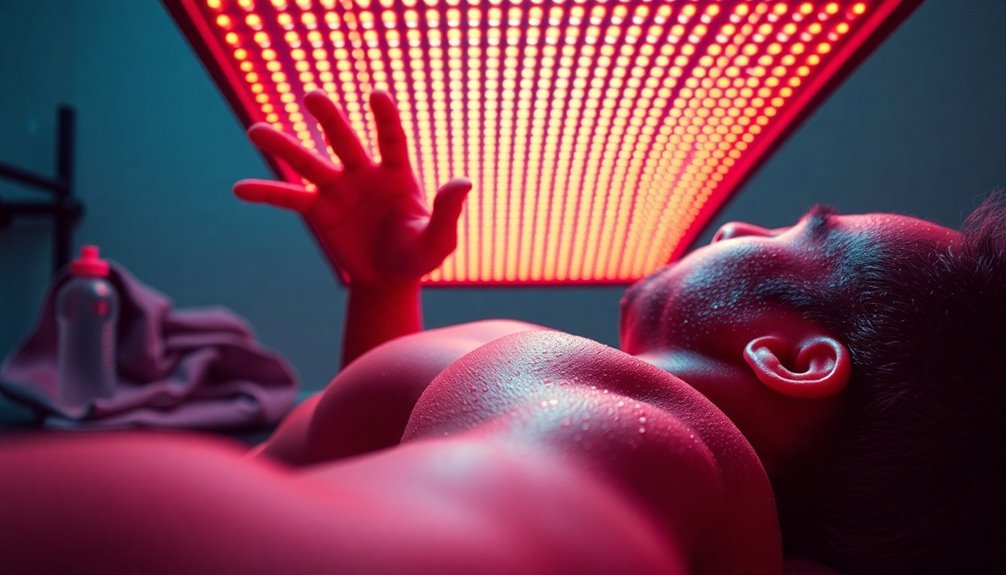
Following intense physical activity, enhancing your recovery phase with red light therapy requires careful timing and consistent application. You'll want to start your recovery session immediately after your workout, as this timing proves most effective for reducing inflammation and muscle soreness.
A 10-20 minute exposure to bare skin will maximize the therapy's benefits, helping your muscles repair and recover faster.
To guarantee you're getting the most from your recovery sessions, consider these essential factors:
- Stay well-hydrated during and after treatment to support cellular recovery processes
- Maintain consistency with 3-4 sessions per week for noticeable improvements
- Expose bare skin directly to the light for maximum absorption and effectiveness
- Monitor your treatment duration, keeping sessions between 10-20 minutes
- Track your progress over 96 hours post-exercise, as benefits continue during this period
Your body's response to red light therapy includes increased ATP production and enhanced muscle fiber repair. When you're consistent with your recovery protocol, you'll likely experience reduced muscle atrophy, decreased inflammation, and improved range of motion.
This systematic approach to recovery can substantially impact your overall training performance and results.
Performance Enhancement Timing
Best timing of red light therapy can considerably boost your athletic performance when strategically planned around workouts. For maximum results, you'll want to schedule your RLT session 3-6 hours before exercise, as this timing aligns with peak ATP production in your cells. This strategic timing guarantees you're getting maximum energy output during your workout while reducing the risk of injury.
| Timing | Benefits | Duration |
|---|---|---|
| 3-6hrs Pre-Workout | Peak ATP Production | 10-20 mins |
| 3-5mins Pre-Workout | Injury Prevention | 3-5 mins |
| Post-Workout | Enhanced Recovery | 10-20 mins |
When you can't schedule your session hours before exercise, a quick 3-5 minute exposure immediately before your workout still provides significant benefits. You'll experience improved blood flow, enhanced muscle preparation, and better mental focus. For maximum effectiveness, guarantee direct skin exposure to the red light and maintain proper hydration throughout your sessions. Keep your exposure under 60 Joules per session, as higher doses won't provide additional benefits and might even be counterproductive. Remember, consistency is key – aim for 3-4 sessions per week to maintain top performance enhancement effects.
Rest Day Implementation
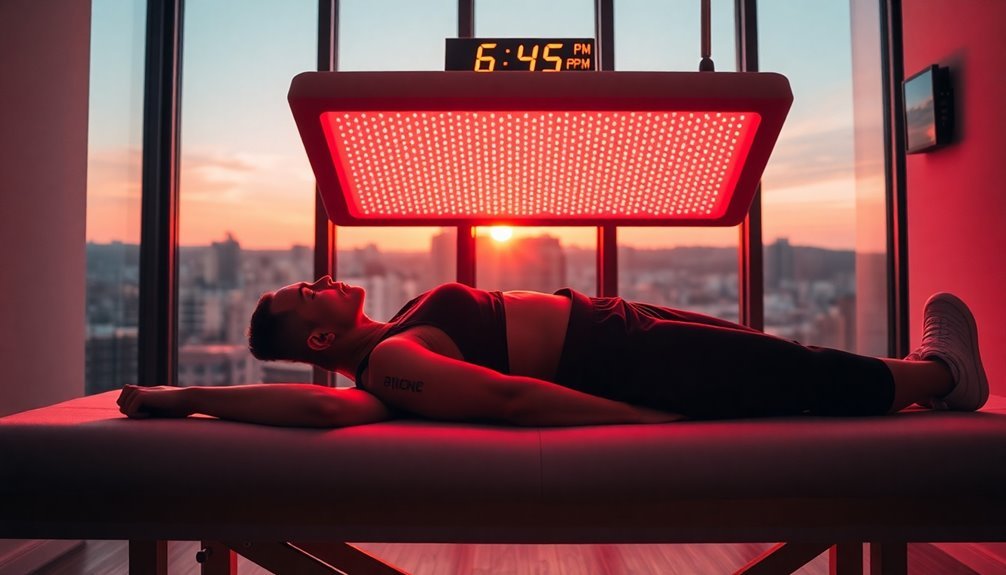
While timing your red light therapy around workouts is valuable, rest days present unique opportunities to maximize recovery benefits. On these days, you'll want to focus on consistent 10-20 minute sessions that support muscle recovery and growth while your body repairs itself.
You can optimize your rest day routine by implementing red light therapy both in the morning and evening for enhanced results.
To make the most of your rest day red light therapy sessions, consider these essential strategies:
- Expose bare skin directly to the light for maximum effectiveness, ensuring proper absorption
- Maintain proper hydration throughout the day to support cellular recovery processes
- Schedule morning sessions to energize your body and evening sessions to promote better sleep
- Aim for 3-4 weekly sessions, focusing on areas that need the most recovery attention
- Keep your exposure time between 10-20 minutes, not exceeding 60 Joules per session
When you're consistent with your rest day therapy, you'll likely notice reduced muscle soreness, improved recovery times, and better overall athletic performance. This approach helps maintain muscle quality during off-training periods while supporting your body's natural healing processes.
Long-Term Treatment Planning
Successfully implementing red light therapy requires a well-structured long-term treatment plan that balances frequency, duration, and consistency. You'll need to start with an initial phase of three sessions per week for two weeks, then shift to a maintenance schedule of one to two sessions weekly.
For the best results, structure your long-term plan according to these evidence-based guidelines:
| Treatment Phase | Implementation Details |
|---|---|
| Initial Phase | 3 sessions/week, 10-20 min each |
| Maintenance | 1-2 sessions/week, 10-20 min each |
| Recovery Focus | Post-workout sessions, 10-20 min |
| Pain Management | 3-5 sessions/week, 6-15 min each |
| Prevention | 1-2 sessions/week, ongoing |
You'll want to maintain consistency while avoiding overuse, as excessive exposure can diminish benefits due to the biphasic dose-response effect. Position yourself 15-50 cm from the light source during sessions, and monitor your skin's response to prevent irritation. For chronic conditions, you'll see gradual improvements over several months, while acute inflammation may show immediate benefits. Remember to adjust your treatment frequency based on your specific goals and your body's response to the therapy.
Frequently Asked Questions
Can I Use Red Light Therapy While Taking Certain Medications?
You'll need to consult your healthcare provider before using red light therapy if you're taking photosensitizing medications. Stop certain drugs like quinidine, anticonvulsants, and cancer medications at least 5 days before treatment.
Does Sweating Affect the Effectiveness of Red Light Therapy Treatment?
Sweating won't directly reduce your red light therapy's effectiveness. However, you'll get the best results by wiping sweat off your skin before treatment, as clean, dry skin allows for maximum light penetration and absorption.
Should I Apply Lotions or Oils Before Red Light Therapy?
You shouldn't apply lotions or oils before red light therapy, as they can block light penetration. Instead, start with clean, product-free skin for maximum effectiveness. Save your skincare products for after the treatment.
Can I Use Red Light Therapy During Active Inflammation or Injury?
Yes, you can safely use red light therapy during active inflammation or injury. It'll help reduce inflammation, promote healing, and support tissue repair. Just maintain recommended treatment durations of 6-15 minutes, 3-5 times weekly.
How Does Altitude or Temperature Affect Red Light Therapy Results?
You'll want to monitor skin temperature during red light therapy since excessive heat can reduce benefits. While altitude doesn't substantially impact results, maintaining proper temperature control and hydration guarantees maximal effectiveness regardless of your location.
In Summary
You'll get the most benefit from red light therapy when you use it within 2-4 hours after exercising, though immediate post-workout sessions can also be effective. Focus on 10-20 minute treatments during this window to optimize muscle recovery and reduce inflammation. Remember to adjust your timing based on your workout intensity and recovery needs, and don't hesitate to incorporate sessions on rest days.

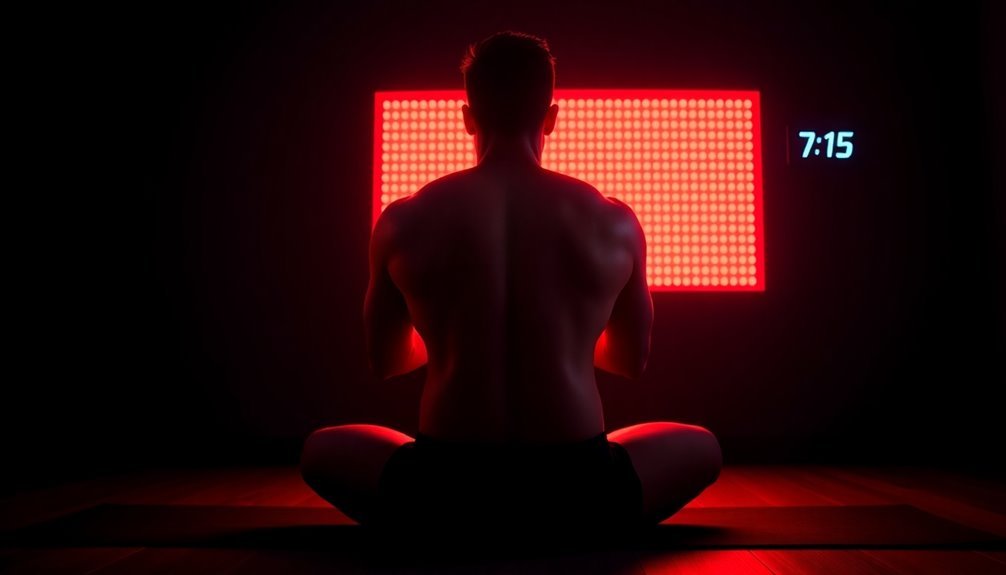



Leave a Reply